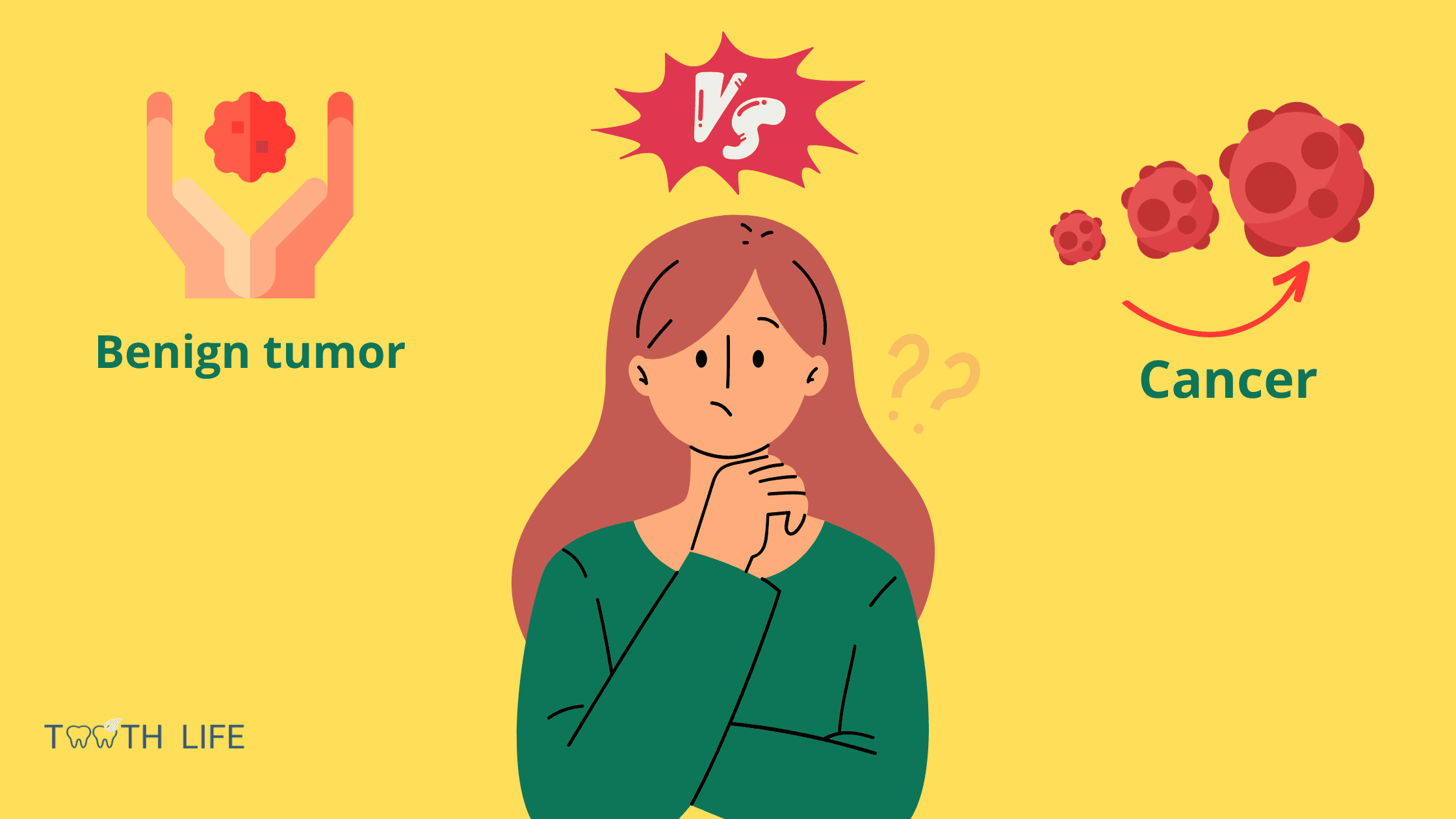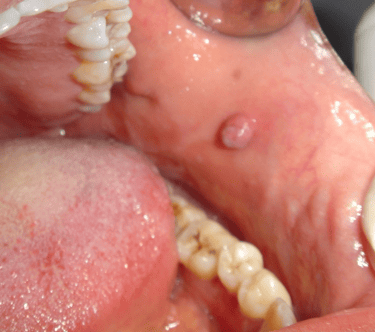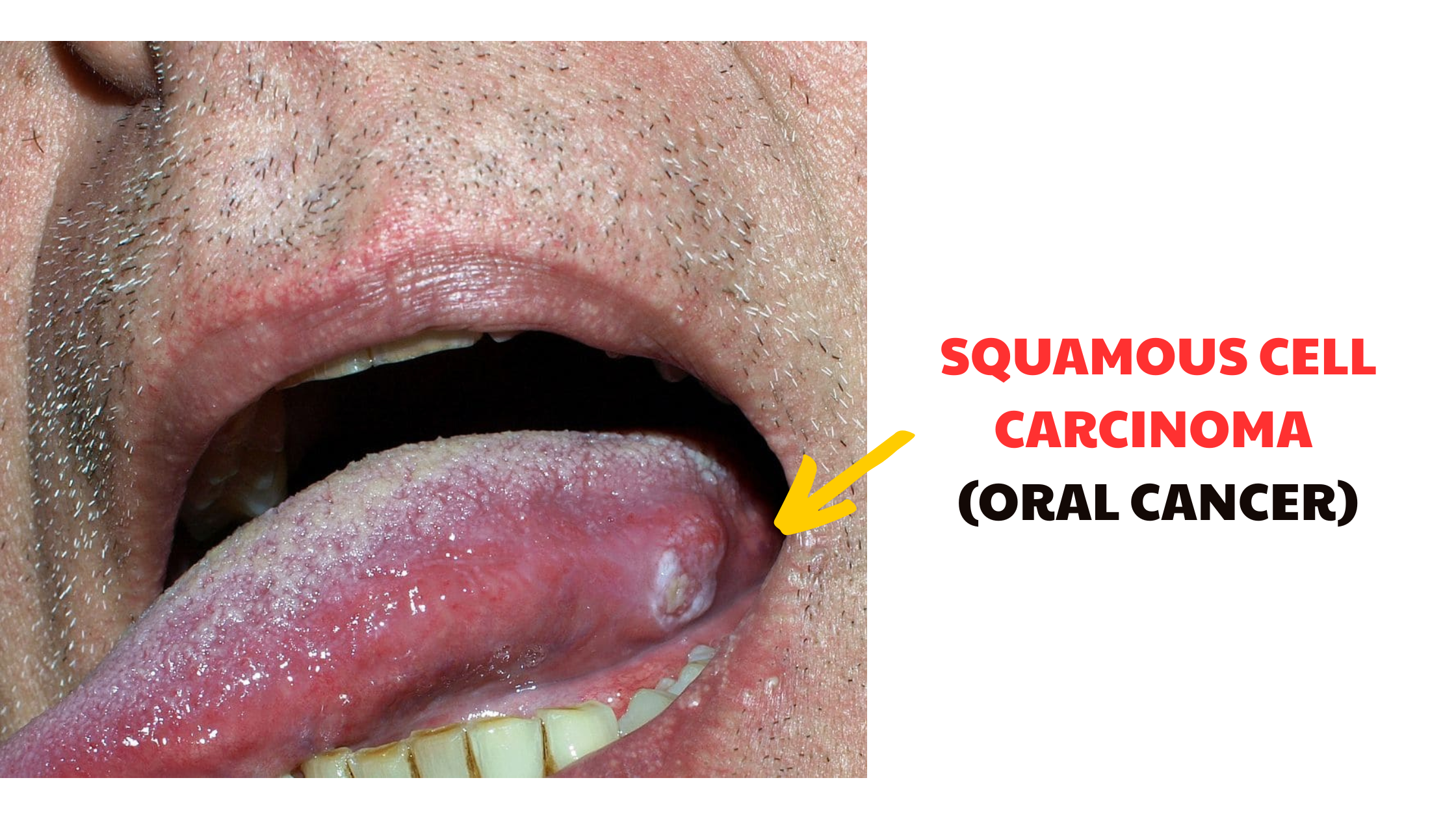Is it a fibroma or oral cancer? How to tell?
 When it comes to tumors in the mouth, they can be divided into two main types: benign and malignant.
When it comes to tumors in the mouth, they can be divided into two main types: benign and malignant.
The good news is that most oral lumps and growths fall into the benign category, meaning they are not harmful.
These benign tumors are named based on the cells or tissues they originate from. For example, "Fibroma", the most common benign tumor of the mouth, (1) refers to fibroblast cells that produce collagen fiber.
While fibromas are harmless, oral cancer is a serious and potentially life-threatening condition, especially if diagnosed at a late stage.
If you notice a lump or lesion in your mouth, there's no need to panic. It's likely a benign tumor. However, it's important to visit your dentist for a proper examination.
In this article, we will explore the differences between fibromas and oral cancer, helping you understand how to tell them apart.
In this article:
1. What is oral fibroma?
2. Can fibroma lead to cancer?
3. How to Tell the Difference Between Fibroma and Oral Cancer?
4. Factors that Can Lead to Oral Cancer:
5. How to prevent fibroma and oral malignancies?
What is oral fibroma?
Oral fibroma is a benign neoplasm or growth that can occur in any area of the mouth.It is more commonly observed in females and typically develops between the ages of 30 and 50 (2). You might notice it as a unique, painless, round, or oval growth in areas such as the gums, tongue, or inside the cheeks.
Typically, these lumpy growths enlarge slowly and can reach a size of 1-2 centimeters (approximately 0.4–0.8 inches). When you touch them, they can feel either firm or soft, and the covering skin usually appears normal. However, if the fibroma gets injured, its surface can turn red or white and even bleed.
These benign tumors are a natural response of the body to long-lasting chronic irritation in the mouth from things like ill-fitting dentures, cheek biting, or braces. To overcome the constant stress, the fibroblast cells in the affected area will grow and overproduce proteins called collagen fibers.
So, fibromas are not as serious as you might think. They are a natural adaptation process, similar to how muscles grow stronger in response to physical stress. Once the cause is removed, the abnormal growth will stop growing and remain stable.

Can fibroma lead to cancer?
Fibromas do not have the characteristics or behavior of cancerous tumors and can never develop into a malignancy. To understand why, let's first understand what cancer is.Cancer occurs when cells in the body grow and multiply uncontrollably. This happens when the genes that regulate cell growth undergo changes or abnormal activity. Factors such as smoking, alcohol, nutritional deficiencies, or certain viral infections can contribute to these changes.
On the other hand, in the case of fibroma, the oncogenes (genes associated with cancer development) and tumor-regulating genes function normally.
Fibroma growth is a local and slow process that does not invade the surrounding tissues. It is a mild reaction that appears in a small area in response to external irritations. Unlike cancer, fibromas remain confined where they first appeared.
In cancer, the changes occur within the cells (in the genes), causing the lesion to grow rapidly and uncontrollably. As it grows, cancer can invade and damage the surrounding tissues.
Therefore, fibroma and cancer are far from being the same thing. In the next section, we'll look at how to tell them apart.
How to Tell the Difference Between Fibroma and Oral Cancer?
If you notice a growth in your mouth that aligns with the signs we've previously discussed, chances are it's a benign fibroma. However, it's still important to visit your dentist promptly to eliminate any doubts. Only a microscopic examination can definitively determine the nature of the lesion you're dealing with. Here are key points to remember when distinguishing between fibroma and oral cancer:1. Size of the tumor:
Fibromas remain relatively small in size, usually reaching about the size of a pea, while oral cancer growths can be larger and vary in size.
2. Rate of growth:
Fibromas have a slow growth rate, whereas oral cancer growths tend to progress more rapidly.
3. Pain:
Fibromas are usually painless, causing minimal discomfort, whereas oral cancer growths can be associated with pain or discomfort.
4. Bleeding:
Fibromas may bleed if injured or irritated, but the bleeding is usually minor. Oral cancer tumors can cause unexplained bleeding, which may be more pronounced.
5. Ulcerations and sores:
Fibromas do not cause ulcerations or open sores. In contrast, oral cancer growth can lead to persistent ulcers or sores that do not heal.
6. Tingling and numbness:
Fibromas do not cause tingling or numbness in the surrounding areas. However, oral cancer growth can sometimes cause tingling or numbness as it pushes into surrounding nerves.
7. Swollen lymph nodes (of the neck and below the lower jaw):
Oral cancer growths may cause the nearby lymph nodes in the neck and below the lower jaw to become swollen and tender. Fibromas, on the other hand, do not typically affect the lymph nodes in this manner.

Factors that Can Lead to Oral Cancer:
The most common form of oral cancer is squamous cell carcinoma (SCC), accounting for 90% of all malignant neoplasms in the mouth.The primary cause of SCC is smoking and all forms of tobacco use, including cigarettes, cigars, and pipes. Surprisingly, smoking is responsible for around two-thirds (more than 60%) of all mouth cancers. (3)
Tobacco smoke itself contains approximately 300 carcinogens (cancer-inducing substances). When these enter the body, they have the potential to damage cells and induce mutations.
In addition to smoking, several other factors can increase the risk of SCC and other forms of oral malignancies. These include:
- Alcohol: Heavy alcohol consumption is another significant risk factor for oral cancer. When combined with smoking, the risk increases even further.
- Nutrition: Poor nutrition, particularly a diet lacking essential vitamins and minerals, has been associated with an increased risk of oral cancer.
- Viral infections: Certain viral infections, such as human papillomavirus (HPV) and Epstein-Barr virus (EBV), have been linked to the development of malignant tumors.
- Genetics: Some individuals may have a genetic predisposition to oral cancer, which can increase their susceptibility to the disease.
- Chronic irritations: These include irritations and injuries from things like ill-fitting dentures, rough or sharp teeth, or constant cheek biting.
- Pre-existing oral conditions: Certain oral diseases, like leukoplakia (white patches in the mouth), have the potential to progress into cancer if left untreated.
How to prevent fibroma and oral malignancies?
Preventing benign or malignant tumors requires adopting healthy habits and minimizing exposure to risk factors. Here are some tips to prevent these conditions:- Avoid or quit smoking: Steer clear of all forms of tobacco, including cigarettes, cigars, pipes, and smokeless tobacco. In addition to the toxic chemicals they contain, smoke overheats the mouth, leading to various forms of lesions.
- Limit alcohol consumption: If you drink alcohol, do so in moderation. Excessive alcohol consumption is associated with an increased risk of oral cancer. It is recommended to follow the guidelines of moderate drinking, which means up to one drink per day for women and up to two drinks per day for men. (4)
- Practice good oral hygiene: Maintain a regular oral hygiene routine that includes brushing your teeth at least twice a day with fluoride toothpaste and flossing daily to help reduce bacteria, plaque buildup, and infections.
- Eat a balanced diet: Include a variety of fruits and vegetables in your diet, as they contain essential nutrients and antioxidants that help support overall oral health. Avoid excessive consumption of processed foods and sugary snacks, which can contribute to oral health issues.
- Visit your dentist regularly: Regular dental check-ups are crucial for early detection and prevention of oral health conditions. Your dentist can identify any signs of fibroma or other abnormalities and provide appropriate treatment.
- Manage chronic irritations: If you suspect your mouth is undergoing irritations due to ill-fitting dentures, rough or sharp teeth, or habits such as cheek biting, treat these issues promptly to avoid chronic injuries that can potentially lead to fibromas or malignant tumors of the mouth.
In the case of fibromas, surgical removal is the typical treatment method, accompanied by addressing the underlying causes to prevent recurrence.
By maintaining good oral hygiene, avoiding tobacco and excessive alcohol consumption, and seeking regular dental care, you can take proactive steps to promote oral health and reduce the risk of oral tumors.
Sources
- Focal fibrous overgrowths: A case series and review of literature - PMC (nih.gov)
- Fibroma epidemiology and demographics - wikidoc
- Oral Mouth Cancer Action Month: Mouth cancer risk factors (dentalhealth.org)
- Alcohol Questions and Answers | CDC
- Essentials of Oral Pathology by Swapan Kumar Purkait (Author)
- Oral Medicine (A Colour Handbook) by Michael A.O. Lewis (Author), Richard C.K. Jordan (Author)